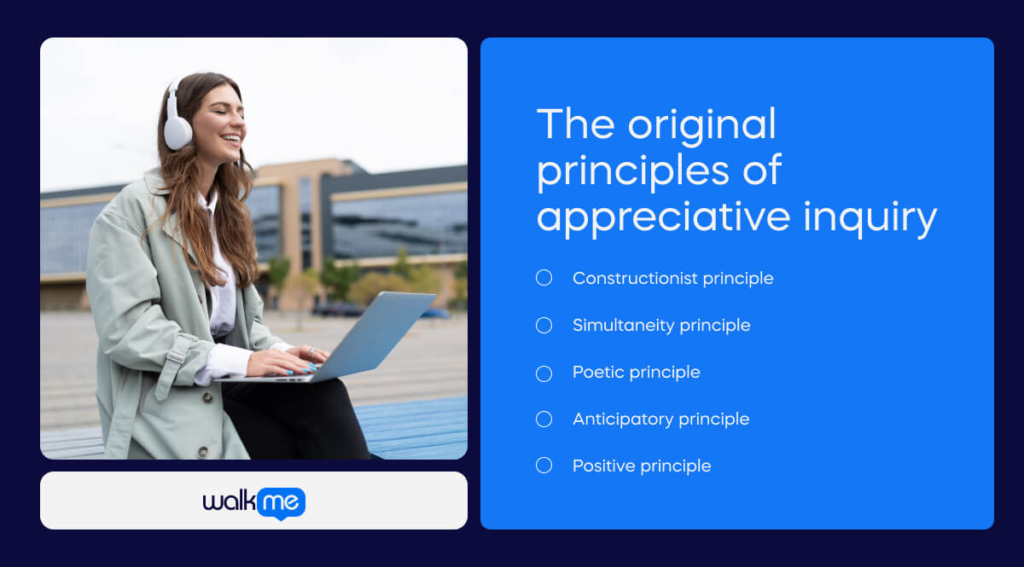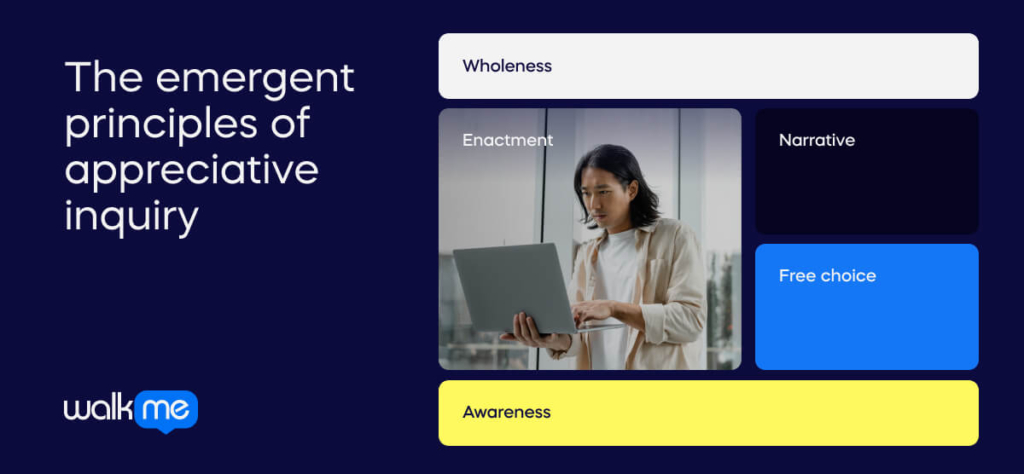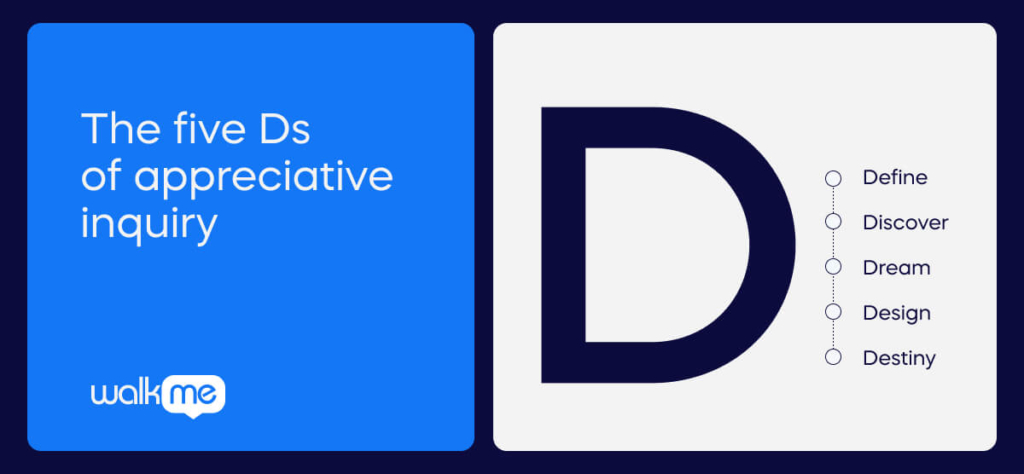Appreciative inquiry: a method for positive change management

Appreciative Inquiry was devised in the 1980s as an innovative method for transforming organizations. Today, it is valued in many sectors and has a natural role in the organizational change management life cycle. Appreciative inquiry offers a unique development approach compared to other common change management methodologies. It focuses on identifying and amplifying strengths and positive aspects within an organization, fostering a more optimistic and collaborative environment for sustainable change.
What is appreciative inquiry?
Appreciative Inquiry (AI) is an approach to organizational development built on the principles of positive psychology. Some change management methods try to figure out solutions to organizational problems. Appreciative inquiry is different. It looks for the positive core strengths that already exist in corporate life and seeks to use those strengths to usher in a better future. Appreciative inquiry practitioners unlock hidden strengths in the community by using generative questions to explore and amplify the positive aspects of individuals and organizations. The appreciative inquiry process is a form of change management or organizational development. AI aligns the organization with a positive vision, driving the design and implementation of projects for a preferred future that suits everyone.
What are the original principles of appreciative inquiry?

Five original principles guide practitioners of appreciative inquiry. They do not define the process of an appreciative inquiry intervention. Rather, they provide a foundational understanding of the world in which AI can make a meaningful impact. The original five principles—constructionist, simultaneity, poetic, anticipatory, and positive—were later joined by five emergent principles, which we will examine in the following section.
Constructionist principle
Appreciative Inquiry holds that reality is socially constructed through language and dialogue. By framing conversations positively, organizations shape their reality and contribute to a more constructive and optimistic culture.
Simultaneity principle
This principle emphasizes that inquiry and change are not separate processes. Asking positive questions initiates a change in perspective, aligning the organization with its positive core and future aspirations.
Poetic principle
The Poetic Principle recognizes that organizations are living stories unfolding. Appreciative Inquiry encourages crafting positive narratives, enabling organizations to envision and live into their preferred future.
Anticipatory principle
Grounded in the belief that what we anticipate influences our actions, the Anticipatory Principle guides AI. By envisioning a positive future, organizations shape their present actions to align with that vision, proactively driving change.
Positive principle
At its core, Appreciative Inquiry operates on a positive assumption about people and organizations. AI catalyzes a positive mindset by focusing on strengths and successes, fostering resilience, creativity, and a collective commitment to transformative change.
What are the emergent principles of appreciative inquiry?

The five emergent principles expand the foundation of appreciative inquiry. Drawn from positive psychology and the experience of change managers, they guide us to a holistic understanding of society and culture in which change can happen effectively.
Wholeness
Appreciative Inquiry (AI) views organizations and human systems as interconnected entities. The principle of wholeness urges a comprehensive exploration of the entire system, emphasizing the need to understand the intricate relationships and dynamics contributing to the system’s functioning. By considering the holistic nature of a system, AI seeks to uncover the interdependencies and interrelated factors that influence its overall well-being.
Enactment
The enactment principle emphasizes that positive change is not just about envisioning a desired future but also about taking action in the present to bring that future into reality. AI encourages individuals and organizations to “act as if” the desired change has already happened, thereby creating a self-fulfilling prophecy. By embodying the values, behaviors, and practices associated with the desired future state, AI practitioners believe that individuals can co-create and accelerate the change process.
Narrative
The narrative principle recognizes the influential role of storytelling in shaping collective understanding. AI leverages the power of shared stories to uncover and amplify positive aspects within an organization or community. AI fosters a positive collective identity by focusing on narratives that highlight strengths, achievements, and successful experiences. This, in turn, contributes to building a shared vision and sense of purpose, driving the desired change.
Free choice
Respect for individual and collective autonomy is central to the free choice principle of AI. Acknowledging that people can choose their actions and responses, AI promotes a sense of agency and ownership in the change process. This principle emphasizes that individuals and groups are more likely to actively engage in and support change initiatives when they feel they can make choices aligned with their values and aspirations.
Awareness
The awareness principle encourages mindfulness and attentiveness to positive aspects within a system. In the context of AI, maintaining awareness involves consciously directing focus toward what is working well and valued. By cultivating a heightened awareness of strengths and positive potential, AI facilitates a constructive and positive approach to change. This principle guides practitioners to actively seek out and appreciate the positive elements that can contribute to the success of the change process.
What are the five Ds of appreciative inquiry?

The five Ds of appreciative inquiry build on the principles outlined above. They serve as a structured framework guiding the AI process. These stages are integral to the AI methodology and offer a systematic organizational or community development approach. Originally, appreciative inquiry had four stages: discovery, dream, define, and destiny. However, many organizational development practitioners also include “define,” so we’ll add that here.
Define
The first step involves defining the scope and focus of the inquiry. Although it is not strictly a part of the Appreciative Inquiry itself, describing the tasks helps clarify many important issues, including the purpose, boundaries, and key objectives of the Appreciative Inquiry process. When you understand those basics, you’re ready to examine what’s happening in an organization.
Discover
In this discovery phase, change agents examine and explore the organization’s positive core. Through dialogues and storytelling, individuals collectively explore strengths, successes, and “life-giving factors,” uncovering the essence that defines the organization at its best.
Dream
Building on the discoveries of the previous stage, the dream phase encourages stakeholders to envision an ideal future. Participants articulate and visualize their aspirations, creating a shared image of what success looks like. This phase is characterized by expansive thinking and co-creating a positive vision.
Design
In the Design phase, the focus shifts to translating the envisioned future into concrete plans and actions. Stakeholders collaboratively design projects and initiatives that align with the positive core and the desired future. This phase bridges the gap between vision and implementation.
Destiny
The final phase, also called the destiny phase, involves implementing the designed projects. This is where the envisioned future becomes a reality. The organization aligns its resources and energies to bring about the positive changes identified during the Appreciative Inquiry process, ultimately shaping its destiny.
What are some examples of appreciative inquiry?
The principles of appreciative inquiry are extremely important. However, the best way to understand this approach is to see it in action. In this section, we’ll take a look at three important moments. First, the invention of appreciative inquiry in the 1980s. Then, community-building actions in the UK in the 2010s. And finally, we will look at how the pandemic presented major opportunities for an appreciative mindset.
The Cleveland Clinic and the birth of appreciative inquiry
The inception of Appreciative Inquiry (AI) at the Cleveland Clinic in 1980 exemplifies a groundbreaking application of this positive approach, At the clinic, Cooperrider was undertaking research to identify problems in the organizational structure. However, he was captivated by the organization’s positive cooperation, innovation, and egalitarian governance. Cooperrider obtained permission from the Clinic’s chairman, Dr. William Kiser, to shift the organizational focus toward life-centric analysis. This marked the birth of AI at a large organizational site, where the inquiry consciously centered on life-giving factors.
The term “Appreciative Inquiry” was introduced in a feedback report for the Cleveland Clinic’s board of governors, generating such positive momentum that the board sought ways to implement this method across the entire organization. The Cleveland Clinic’s adoption of Appreciative Inquiry revolutionized its organizational culture and demonstrated the profound impact of a positive approach on healthcare delivery and patient outcomes. The AI process offered a novel and effective way to explore an organization’s inherent strengths, inspiring positive change and sustained excellence.
Building community in the UK
For our next example, we’ll look at something completely different. In the 2010s, researchers in the UK decided to use appreciative inquiry to build community and collective power among Pakistani women in Sheffield. They wanted to understand social and cultural factors contributing to the persistent disadvantage of this group of people. In this case, Appreciative Inquiry helped develop a new and emancipatory consciousness among women who believed they were incapable of learning. By encouraging the telling of untold stories, AI created a new level of critical consciousness and power within the group.
The results positively impacted the participants’ confidence, self-identity, and ability to challenge the societal constructs imposed on them. This work is not, of course, drawn from the business world. But it is an amazing example of the positive impact of the right questions on human systems. By creating a space for authentic dialogue, storytelling, and reflection, AI becomes a holistic approach that promotes a deep understanding and response to power relationships within communities or organizations. There are many comparable settings in which generative themes can t disrupt self-limiting assumptions.
Appreciative inquiry in the pandemic
At a more theoretical level, at the start of Covid-19. Commentators emphasized the positive impact that appreciative inquiry could have on society’s resilience in adversity. In June 2020, a team of VCU writers indicated the lessons AI could teach us about handling a challenge on this scale. Looking back on their insights, they suggest some excellent ways to handle unexpected crises. Their first emphasis was that positivity leads to generativeness. They now focus on fostering new ideas, theories, and models that elevate collective aspirations and unlock decisions and actions previously unconsidered.
Another way to succeed is the technique of reframing. This technique turns problems into opportunities, and recognizing strengths and fostering curiosity becomes essential. The power of reframing challenges associated with COVID-19 was exemplified through generative questions and the “flipping” technique, encouraging a shift from deficit-based to opportunity-based perspectives. AI’s foundational premise is identifying and leveraging the positive core. By exploring success elements and strengths through inquiries, individuals and teams can carry forward the root causes of success into new challenges. Curiosity, integral to AI, promotes asking questions over advocacy statements, enriching relationships, and deepening understanding. Active Constructive Responding, as termed by Seligman, aligns with this curiosity-driven communication strategy, fostering learning and growth.
Appreciative inquiry for a positive revolution
Appreciative inquiry has had some remarkable success stories in its forty-year history, as the Centre for Appreciative Inquiry abundantly shows. However, these examples may seem far from the change initiatives that corporative organizational development practitioners face. However, AI is an excellent way to introduce positive organizational change. It may take a slightly different view of the situation. But with an emphasis on positivity, problem-solving, and unlocking potential, it is very effective at bringing every member of an organization along for the ride.